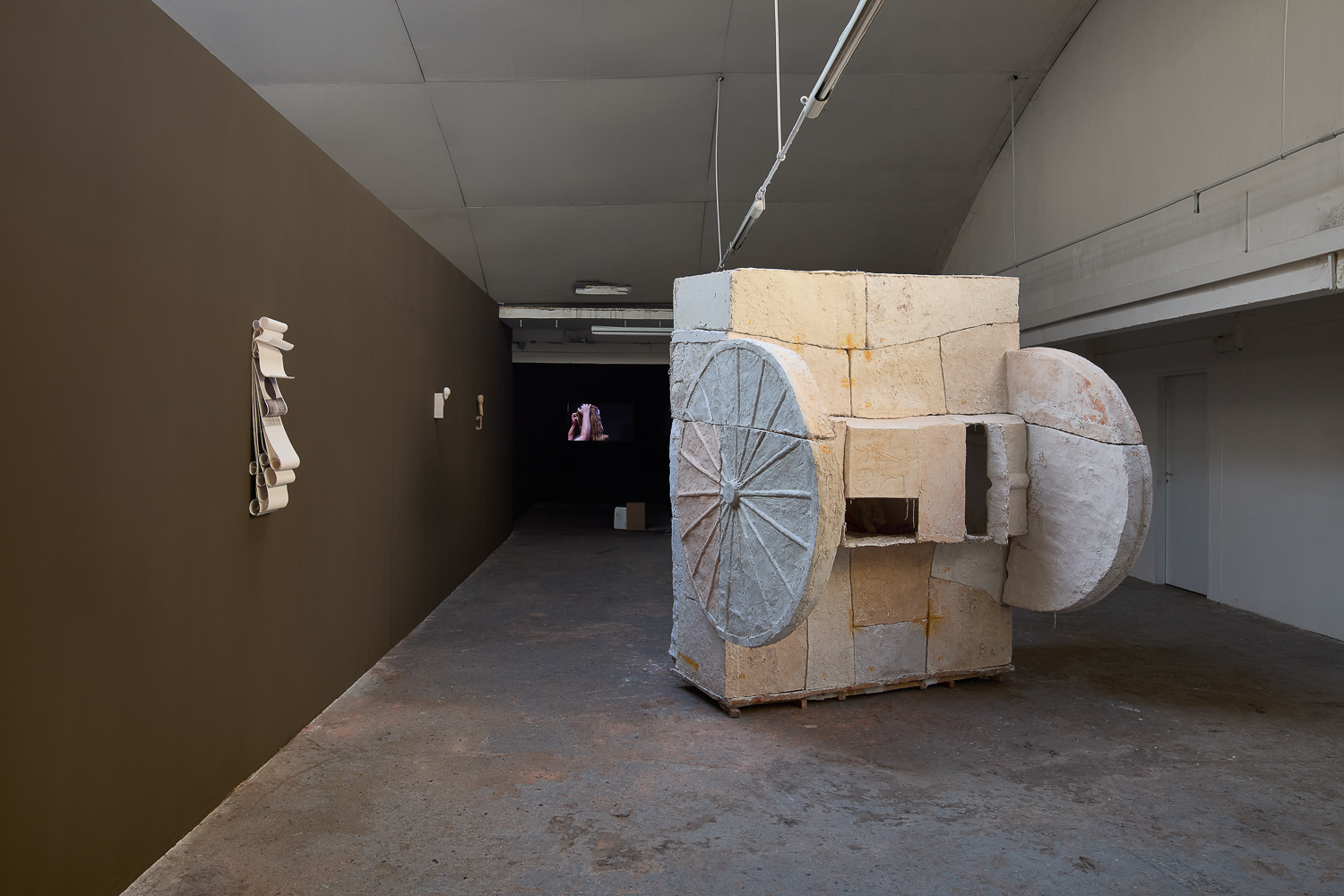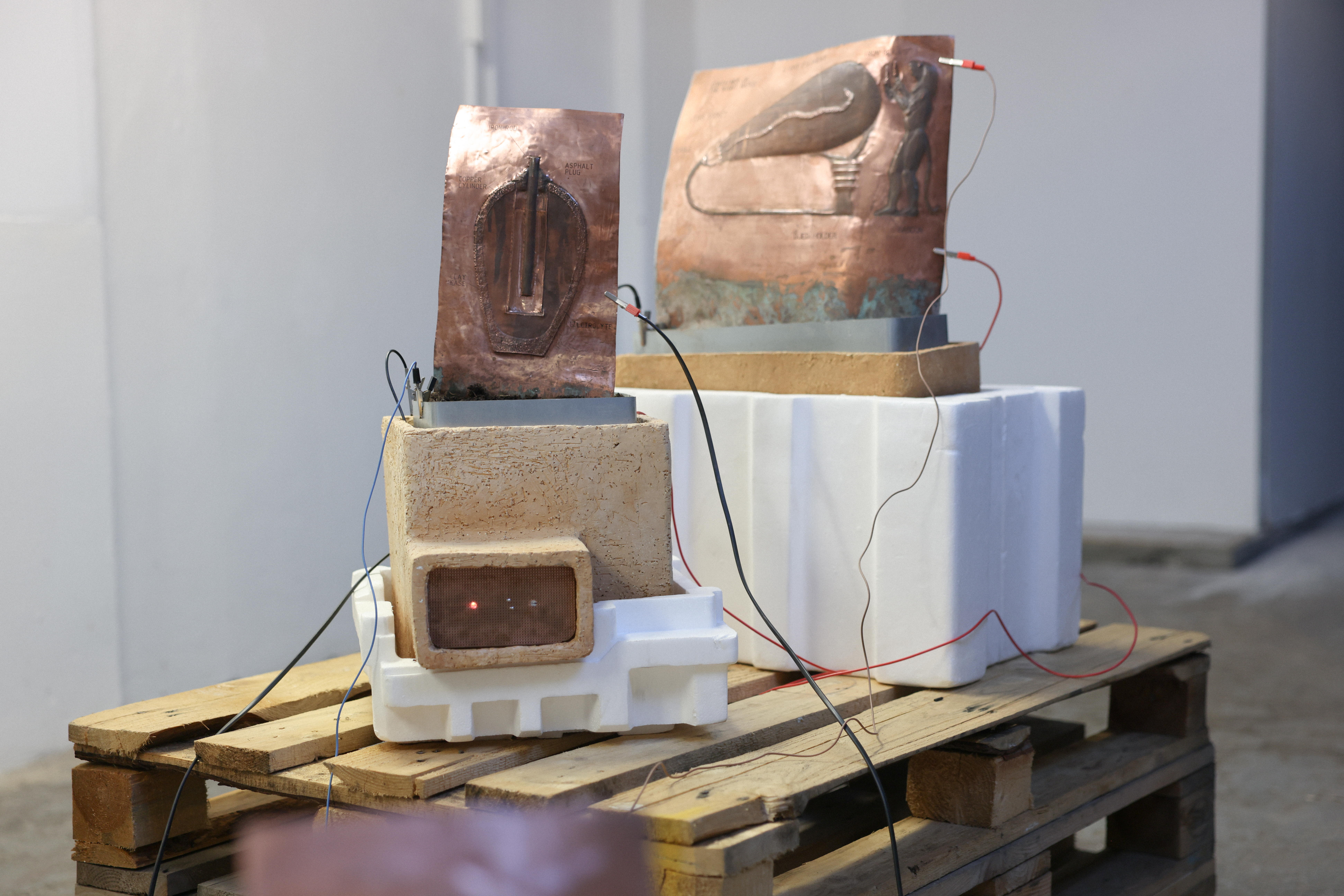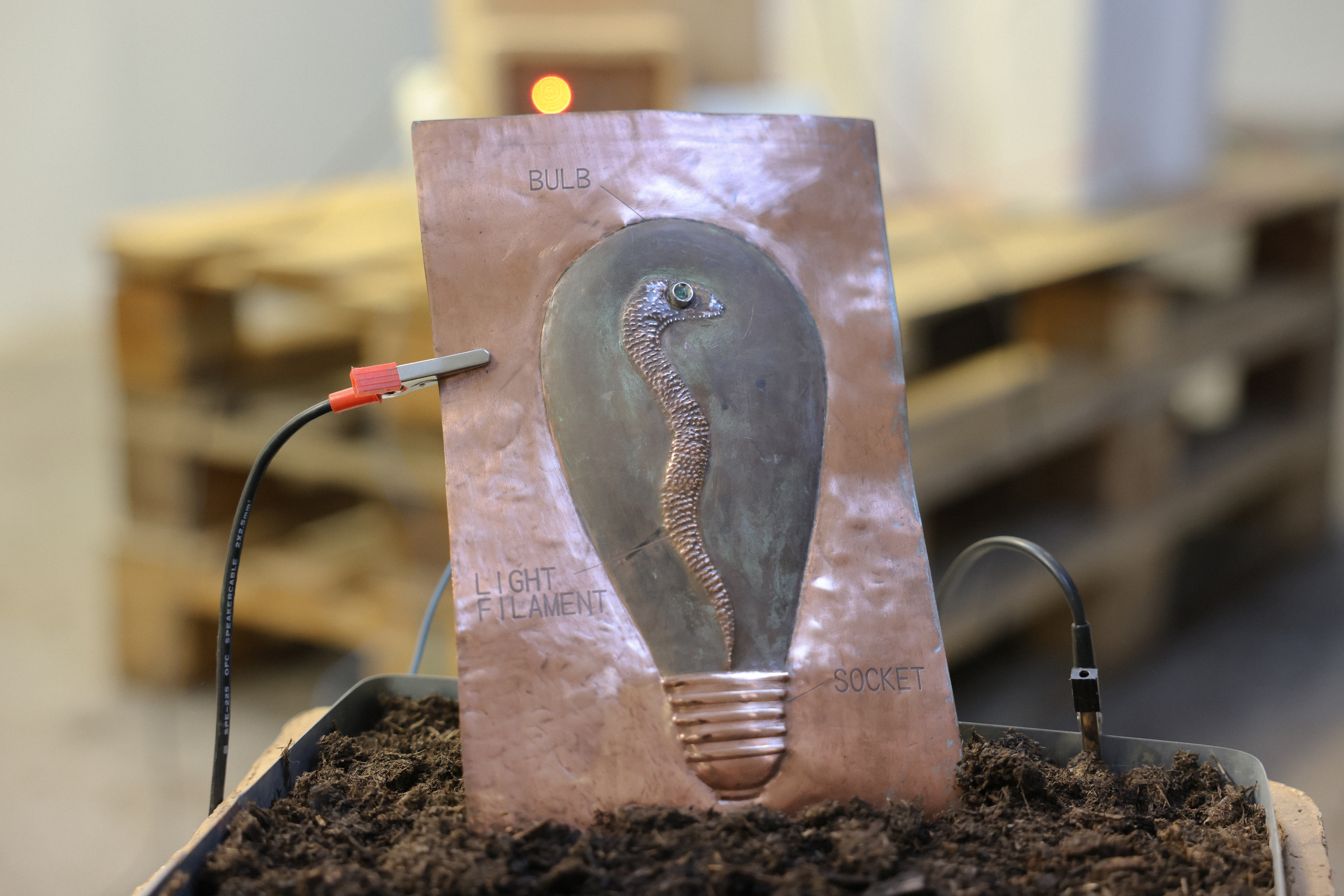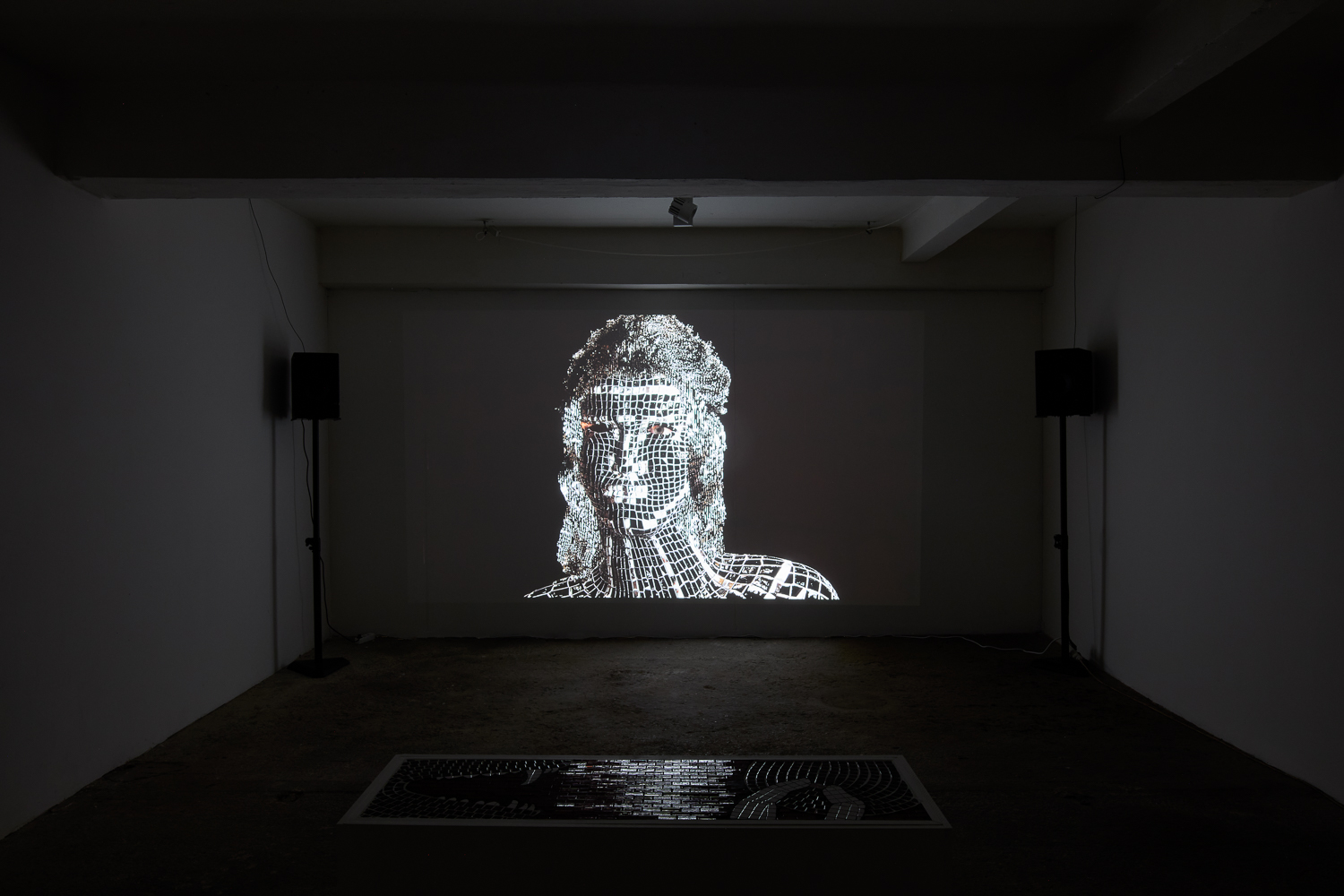Estranged Tools
curated by: Natálie Kubíková, Mia Milgrom
artists: Hynek Alt, Kateřina Komm, Barbora Dayef, Selmeci Kocka Jusko, Markéta Magidová
opening 29.4. (18:00)
30.4. - 24.5. 2025
24.5. dernissage with screenings of Markéta Magidová's films
ENG//
The exhibition Estranged Tools perceives technology not only as instruments of progress but also as historical cultural phenomena intertwined with myths, speculative stories, and visions of possible futures. The individual works explore the deep connections between technological artifacts and narrative structures, viewing technology in the spirit of its original Greek meaning — as an expression of art and craft (techné).
Thus, technology is not understood as a neutral medium of a digitized present, but as an active, formative force that fundamentally shapes communication models, community cohesion, and ecological relationships. The exhibition presents technology as a nonlinear, networked system of meanings and possibilities, in which tools — the products of human invention — simultaneously co-create human subjectivity. These artifacts, removed from their original contexts, bear traces of uncertain pasts and open up spaces for speculation about future scenarios.
In her monumental projects, Kateřina Komm combines her own intimate memories with collective memory. Composed Way contrasts an overturned cart with a self-portrait hidden within its cavity. The idea of coming of age and personal growth is depicted through an old relief, which the artist has adapted to portray herself and her husband. The scale of each work is in dialogue with the scale of the human body — either through casts taken directly from observed figures, or through the process of photographing herself in various compositions with the sculptures, emphasizing a relationship where one cannot exist without the other. Building on traditional sculptural techniques, Komm develops a deeply conceptual language to explore themes of motherhood, familial love, as well as categorization and systems of support. The wheel here functions not only as a reminder of an ancient invention that fundamentally transformed human society but also as a symbol of constant movement and the relationship between humans and tools.
Hynek Alt continually explores the human condition in the context of the contemporary digital era and the artificial structures behind it. Alt's post-conceptual strategies include various media, expanding from photography to video and sculpture. The CGI-rendered dog in Untitled (Howl) mirrors the movements and sounds of a drunk human, blending the notions of the wild and the domestic into one. Periodically howling and then falling asleep, the dog's rhythm refers to the cycles of social media presence as well as work hours. Untitled (Stranger I, for Sam) and Untitled (Stranger II, for Exile), carefully placed on opposing walls, serve as symbolic gestures of greeting. Printed via fax machine, they physically connect distant places, acknowledging a bond mediated through a machine.
The theme of the relationship between humans and machines, whose roots reach back to antiquity, is embodied by the mythical Talos — the first automaton — representing the fusion of craft, technology, and myth. In many stories, machines are described as being made from the same materials and techniques that artisans used in the creation of tools and sculptures; thus, techné becomes a bridge between natural materials and objects unknown to nature.
The sculptural work of Barbora Dayef draws from the study of ancient technologies, particularly those of the Middle East. Fringe Sources is an apparatus inspired by archaeological findings of devices that produced electricity. A key focus here is the exploration of clay’s potential as an energy source. Through DIY methods, the sculptures aim to democratize electricity production and bring it into physical proximity. References to the Baghdad Battery, Egyptian reliefs, and Hindu temples challenge the notion of electricity as a purely modern phenomenon and speculatively expand its historical significance.
Markéta Magidová combines playful aesthetics with feminist themes, challenging social norms and creating alternative fictional worlds inspired by memories or utopian visions. The animated film Infamia, created using CGI, tells a violent story set in ancient Pompeii. The film follows the fates of two characters living on the margins of society — Mola, a prostitute, and Rusticus, a gladiator. As representatives of socially stigmatized groups, Mola and Rusticus are portrayed in a constant tension between their personal longing for autonomy and the structural forces that determine their lives. The film thus emphasizes issues of freedom, identity, and dignity under conditions of institutional oppression, creating space for a critical reflection on power relations in both ancient and contemporary societies.
The artistic duo Selmeci Kocka Jusko creates installations at the intersection of architecture, art, and design. Each of their works is based on a specific phenomenon or metaphor, and in its abstracted form offers subtle hints of its original inspiration. The exhibited samples from the Appearing Flower series evoke everyday objects as well as archaeological traces, serving as foundations for the duo’s observation and subsequent creative process. A conscious play with scale and negative space introduces a speculative tone that transforms every gesture into a communicative tool.
Through the diverse approaches and media of the participating artists, Estranged Tools demonstrates that technologies are not merely tools, but active agents of cultural imagination. Here, artifacts lose their instrumental clarity and become open structures carrying stories, memory, and speculative visions. The exhibition invites a rethinking of the relationship between humans and technology, and a search for new forms of coexistence in a changing world, where the boundaries between the natural, the artificial, and the narrative are constantly being redrawn.
CZ//
Výstava Estranged Tools vnímá technologie nejen jako nástroje pokroku, ale jako historické kulturní jevy, které jsou spojené s mýty, spekulativními příběhy a vizemi možných budoucností. Jednotlivá díla tematizují hluboké vazby mezi technologickými artefakty a narativními strukturami, přičemž technologie je zde nahlížena v duchu jejího původního řeckého významu, jako projev umění a řemesla (techné).
Technologie tak není chápána jako neutrální prostředek digitalizované současnosti, nýbrž jako aktivní formotvorná síla, jež zásadně ovlivňuje komunikační modely, soudržnost komunit a ekologické vazby. Výstava ukazuje technologii jako nelineární, síťovitý systém významů a možností, v němž nástroje, výsledky lidské invence, spolu zároveň utvářejí lidskou subjektivitu. Tyto artefakty, vytržené ze svých původních kontextů, nesou stopy neurčitých minulostí a otevírají prostor pro spekulace o budoucích scénářích.
Ve svých monumentálních projektech Kateřina Komm spojuje vlastní intimní vzpomínky s kolektivní pamětí. Composed Way staví do kontrastu převržený vůz a autoportrét skrytý v jeho dutině. Myšlenka dospívání a osobního růstu je zde zobrazena ve starém reliéfu, který autorka upravila tak, aby zachytil ji a jejího manžela. Měřítko každého díla je v dialogu s měřítkem lidského těla — buď skrze odlitky vycházející přímo z pozorované figury, nebo skrze proces fotografování sebe sama v různých kompozicích se sochami, čímž je zdůrazňen proces, v němž jedno nemůže existovat bez druhého. Komm, vycházející z tradičních sochařských technik, rozvíjí hluboce konceptuální jazyk, kterým otevírá témata mateřství, rodinné lásky, ale také kategorizace a podpůrného systému. Kolo zde může fungovat nejen jako připomínka starověkého vynálezu, jenž zásadně proměnil vývoj lidské společnosti, ale také jako symbol neustálého pohybu a vztahu mezi lidmi a nástroji.
Hynek Alt se dlouhodobě zabývá otázkami lidské existence v kontextu digitální éry a struktur, které ji formují. Prostřednictvím postkonceptuálních strategií zkoumá proměny identity a vztahu k realitě. V díle Untitled (Howl) CGI pes napodobuje chování opilého člověka a propojuje obrazy divokého a domestikovaného. Animovaný pes periodicky vyje a poté usíná; jeho rytmus odkazuje jak na cykly offline a online přítomnosti na sociálních sítích, tak na pracovní dobu. Faxové tisky Untitled (Stranger I, for Sam) a Untitled (Stranger II, for Exile), umístěné na protilehlých stěnách propojují vzálená místa a připomínají tak vztah zprostředkovaný strojem.
Téma vztahu lidí a strojů, jehož kořeny sahají do starověku, zobrazuje mýtický Talos, první automaton, ztělesňující propojení řemesla, technologií a mýtu. V mnoha příbězích jsou stroje popisovány jako zhotovené ze stejných materiálů a technik, jaké používali řemeslníci při výrobě nástrojů a soch, techné se tedy stává mostem mezi přírodními materiály a objekty, které jsou přírodě neznámými.
Sochařská tvorba Barbory Dayef čerpá ze studia starověkých technologií, zejména z oblasti Blízkého východu. Fringe Sources je aparát inspirovaný archeologickými nálezy zařízení produkujících elektřinu. Klíčovým momentem je zde testování možností hlíny jako energetického zdroje. Pomocí DIY postupů sochy usilují o demokratizaci výroby elektřiny a její fyzickou blízkost. Odkazy na Bagdádskou baterii, egyptské reliéfy či hinduistické chrámy zpochybňují představy o elektřině jako moderním fenoménu a spekulativně rozšiřují její historický význam.
Markéta Magidová kombinuje hravou estetiku s feministickými tématy, zpochybňuje sociální normy a vytváří alternativní fiktivní světy inspirované vzpomínkami či utopickými vizemi. Animovaný film Infamia, realizovaný pomocí CGI, vypráví násilný příběh, který je zasazen do starověkých Pompejí. Film sleduje osudy dvou postav nacházejících se na okraji tehdejší společnosti, prostitutky Mola a gladiátora Rustica. Mola a Rusticus, představitelé sociálně stigmatizovaných skupin, jsou zde zobrazení v neustálém napětí mezi osobní touhou po autonomii a strukturálními silami, které jejich životy determinují. Film tak klade důraz na problematiku svobody, identity a důstojnosti v podmínkách institucionálního útlaku a vytváří prostor pro kritickou reflexi mocenských vztahů ve společnosti jak antické, tak současné.
Umělecké duo Selmeci Kocka Jusko vytváří instalace na pomezí architektury, umění a designu. Každé jejich dílo vychází z určitého fenoménu nebo metafory a ve své abstrahované formě nabízí náznaky původního podnětu. Vystavené "samples" ze série Appearing Flower připomínají každodenní předměty i archeologické stopy, které jsou základem pozorování a následného tvůrčího procesu dua. Vědomá hra s měřítkem a negativním prostorem umožňuje spekulativní tón, který proměňuje každé gesto v komunikační nástroj.
Skrze rozmanité přístupy a média jednotlivých autorů výstava Estranged Tools ukazuje, že technologie nejsou pouze nástroji, ale i aktivními aktéry kulturní imaginace. Artefakty zde ztrácejí svou instrumentální jednoznačnost a stávají se otevřenými strukturami nesoucími příběhy, paměť i spekulativní vize. Výstava tak vyzývá k přehodnocení vztahu mezi člověkem a technologií a k hledání nových forem spolužití v proměnlivém světě, kde se hranice mezi přírodním, umělým a narativním neustále překreslují.
photos by:
graphic design: Selmeci Kocka Jusko
curated by: Natálie Kubíková, Mia Milgrom
artists: Hynek Alt, Kateřina Komm, Barbora Dayef, Selmeci Kocka Jusko, Markéta Magidová
opening 29.4. (18:00)
30.4. - 24.5. 2025
24.5. dernissage with screenings of Markéta Magidová's films
ENG//
The exhibition Estranged Tools perceives technology not only as instruments of progress but also as historical cultural phenomena intertwined with myths, speculative stories, and visions of possible futures. The individual works explore the deep connections between technological artifacts and narrative structures, viewing technology in the spirit of its original Greek meaning — as an expression of art and craft (techné).
Thus, technology is not understood as a neutral medium of a digitized present, but as an active, formative force that fundamentally shapes communication models, community cohesion, and ecological relationships. The exhibition presents technology as a nonlinear, networked system of meanings and possibilities, in which tools — the products of human invention — simultaneously co-create human subjectivity. These artifacts, removed from their original contexts, bear traces of uncertain pasts and open up spaces for speculation about future scenarios.
In her monumental projects, Kateřina Komm combines her own intimate memories with collective memory. Composed Way contrasts an overturned cart with a self-portrait hidden within its cavity. The idea of coming of age and personal growth is depicted through an old relief, which the artist has adapted to portray herself and her husband. The scale of each work is in dialogue with the scale of the human body — either through casts taken directly from observed figures, or through the process of photographing herself in various compositions with the sculptures, emphasizing a relationship where one cannot exist without the other. Building on traditional sculptural techniques, Komm develops a deeply conceptual language to explore themes of motherhood, familial love, as well as categorization and systems of support. The wheel here functions not only as a reminder of an ancient invention that fundamentally transformed human society but also as a symbol of constant movement and the relationship between humans and tools.
Hynek Alt continually explores the human condition in the context of the contemporary digital era and the artificial structures behind it. Alt's post-conceptual strategies include various media, expanding from photography to video and sculpture. The CGI-rendered dog in Untitled (Howl) mirrors the movements and sounds of a drunk human, blending the notions of the wild and the domestic into one. Periodically howling and then falling asleep, the dog's rhythm refers to the cycles of social media presence as well as work hours. Untitled (Stranger I, for Sam) and Untitled (Stranger II, for Exile), carefully placed on opposing walls, serve as symbolic gestures of greeting. Printed via fax machine, they physically connect distant places, acknowledging a bond mediated through a machine.
The theme of the relationship between humans and machines, whose roots reach back to antiquity, is embodied by the mythical Talos — the first automaton — representing the fusion of craft, technology, and myth. In many stories, machines are described as being made from the same materials and techniques that artisans used in the creation of tools and sculptures; thus, techné becomes a bridge between natural materials and objects unknown to nature.
The sculptural work of Barbora Dayef draws from the study of ancient technologies, particularly those of the Middle East. Fringe Sources is an apparatus inspired by archaeological findings of devices that produced electricity. A key focus here is the exploration of clay’s potential as an energy source. Through DIY methods, the sculptures aim to democratize electricity production and bring it into physical proximity. References to the Baghdad Battery, Egyptian reliefs, and Hindu temples challenge the notion of electricity as a purely modern phenomenon and speculatively expand its historical significance.
Markéta Magidová combines playful aesthetics with feminist themes, challenging social norms and creating alternative fictional worlds inspired by memories or utopian visions. The animated film Infamia, created using CGI, tells a violent story set in ancient Pompeii. The film follows the fates of two characters living on the margins of society — Mola, a prostitute, and Rusticus, a gladiator. As representatives of socially stigmatized groups, Mola and Rusticus are portrayed in a constant tension between their personal longing for autonomy and the structural forces that determine their lives. The film thus emphasizes issues of freedom, identity, and dignity under conditions of institutional oppression, creating space for a critical reflection on power relations in both ancient and contemporary societies.
The artistic duo Selmeci Kocka Jusko creates installations at the intersection of architecture, art, and design. Each of their works is based on a specific phenomenon or metaphor, and in its abstracted form offers subtle hints of its original inspiration. The exhibited samples from the Appearing Flower series evoke everyday objects as well as archaeological traces, serving as foundations for the duo’s observation and subsequent creative process. A conscious play with scale and negative space introduces a speculative tone that transforms every gesture into a communicative tool.
Through the diverse approaches and media of the participating artists, Estranged Tools demonstrates that technologies are not merely tools, but active agents of cultural imagination. Here, artifacts lose their instrumental clarity and become open structures carrying stories, memory, and speculative visions. The exhibition invites a rethinking of the relationship between humans and technology, and a search for new forms of coexistence in a changing world, where the boundaries between the natural, the artificial, and the narrative are constantly being redrawn.
CZ//
Výstava Estranged Tools vnímá technologie nejen jako nástroje pokroku, ale jako historické kulturní jevy, které jsou spojené s mýty, spekulativními příběhy a vizemi možných budoucností. Jednotlivá díla tematizují hluboké vazby mezi technologickými artefakty a narativními strukturami, přičemž technologie je zde nahlížena v duchu jejího původního řeckého významu, jako projev umění a řemesla (techné).
Technologie tak není chápána jako neutrální prostředek digitalizované současnosti, nýbrž jako aktivní formotvorná síla, jež zásadně ovlivňuje komunikační modely, soudržnost komunit a ekologické vazby. Výstava ukazuje technologii jako nelineární, síťovitý systém významů a možností, v němž nástroje, výsledky lidské invence, spolu zároveň utvářejí lidskou subjektivitu. Tyto artefakty, vytržené ze svých původních kontextů, nesou stopy neurčitých minulostí a otevírají prostor pro spekulace o budoucích scénářích.
Ve svých monumentálních projektech Kateřina Komm spojuje vlastní intimní vzpomínky s kolektivní pamětí. Composed Way staví do kontrastu převržený vůz a autoportrét skrytý v jeho dutině. Myšlenka dospívání a osobního růstu je zde zobrazena ve starém reliéfu, který autorka upravila tak, aby zachytil ji a jejího manžela. Měřítko každého díla je v dialogu s měřítkem lidského těla — buď skrze odlitky vycházející přímo z pozorované figury, nebo skrze proces fotografování sebe sama v různých kompozicích se sochami, čímž je zdůrazňen proces, v němž jedno nemůže existovat bez druhého. Komm, vycházející z tradičních sochařských technik, rozvíjí hluboce konceptuální jazyk, kterým otevírá témata mateřství, rodinné lásky, ale také kategorizace a podpůrného systému. Kolo zde může fungovat nejen jako připomínka starověkého vynálezu, jenž zásadně proměnil vývoj lidské společnosti, ale také jako symbol neustálého pohybu a vztahu mezi lidmi a nástroji.
Hynek Alt se dlouhodobě zabývá otázkami lidské existence v kontextu digitální éry a struktur, které ji formují. Prostřednictvím postkonceptuálních strategií zkoumá proměny identity a vztahu k realitě. V díle Untitled (Howl) CGI pes napodobuje chování opilého člověka a propojuje obrazy divokého a domestikovaného. Animovaný pes periodicky vyje a poté usíná; jeho rytmus odkazuje jak na cykly offline a online přítomnosti na sociálních sítích, tak na pracovní dobu. Faxové tisky Untitled (Stranger I, for Sam) a Untitled (Stranger II, for Exile), umístěné na protilehlých stěnách propojují vzálená místa a připomínají tak vztah zprostředkovaný strojem.
Téma vztahu lidí a strojů, jehož kořeny sahají do starověku, zobrazuje mýtický Talos, první automaton, ztělesňující propojení řemesla, technologií a mýtu. V mnoha příbězích jsou stroje popisovány jako zhotovené ze stejných materiálů a technik, jaké používali řemeslníci při výrobě nástrojů a soch, techné se tedy stává mostem mezi přírodními materiály a objekty, které jsou přírodě neznámými.
Sochařská tvorba Barbory Dayef čerpá ze studia starověkých technologií, zejména z oblasti Blízkého východu. Fringe Sources je aparát inspirovaný archeologickými nálezy zařízení produkujících elektřinu. Klíčovým momentem je zde testování možností hlíny jako energetického zdroje. Pomocí DIY postupů sochy usilují o demokratizaci výroby elektřiny a její fyzickou blízkost. Odkazy na Bagdádskou baterii, egyptské reliéfy či hinduistické chrámy zpochybňují představy o elektřině jako moderním fenoménu a spekulativně rozšiřují její historický význam.
Markéta Magidová kombinuje hravou estetiku s feministickými tématy, zpochybňuje sociální normy a vytváří alternativní fiktivní světy inspirované vzpomínkami či utopickými vizemi. Animovaný film Infamia, realizovaný pomocí CGI, vypráví násilný příběh, který je zasazen do starověkých Pompejí. Film sleduje osudy dvou postav nacházejících se na okraji tehdejší společnosti, prostitutky Mola a gladiátora Rustica. Mola a Rusticus, představitelé sociálně stigmatizovaných skupin, jsou zde zobrazení v neustálém napětí mezi osobní touhou po autonomii a strukturálními silami, které jejich životy determinují. Film tak klade důraz na problematiku svobody, identity a důstojnosti v podmínkách institucionálního útlaku a vytváří prostor pro kritickou reflexi mocenských vztahů ve společnosti jak antické, tak současné.
Umělecké duo Selmeci Kocka Jusko vytváří instalace na pomezí architektury, umění a designu. Každé jejich dílo vychází z určitého fenoménu nebo metafory a ve své abstrahované formě nabízí náznaky původního podnětu. Vystavené "samples" ze série Appearing Flower připomínají každodenní předměty i archeologické stopy, které jsou základem pozorování a následného tvůrčího procesu dua. Vědomá hra s měřítkem a negativním prostorem umožňuje spekulativní tón, který proměňuje každé gesto v komunikační nástroj.
Skrze rozmanité přístupy a média jednotlivých autorů výstava Estranged Tools ukazuje, že technologie nejsou pouze nástroji, ale i aktivními aktéry kulturní imaginace. Artefakty zde ztrácejí svou instrumentální jednoznačnost a stávají se otevřenými strukturami nesoucími příběhy, paměť i spekulativní vize. Výstava tak vyzývá k přehodnocení vztahu mezi člověkem a technologií a k hledání nových forem spolužití v proměnlivém světě, kde se hranice mezi přírodním, umělým a narativním neustále překreslují.
photos by:
graphic design: Selmeci Kocka Jusko






